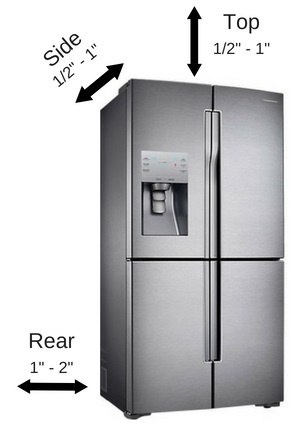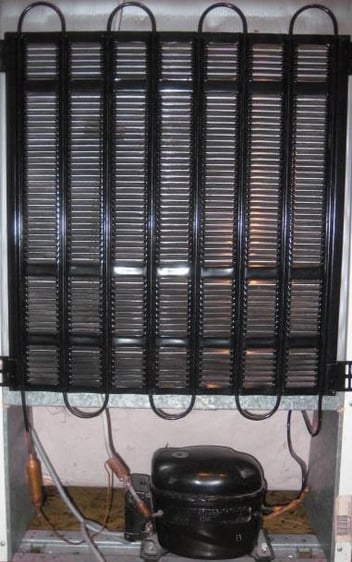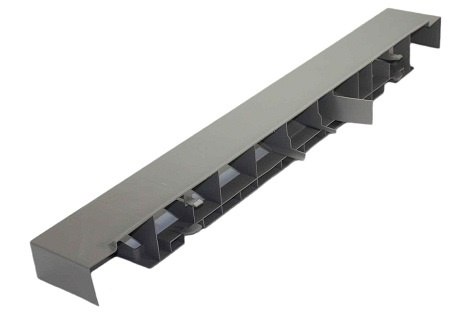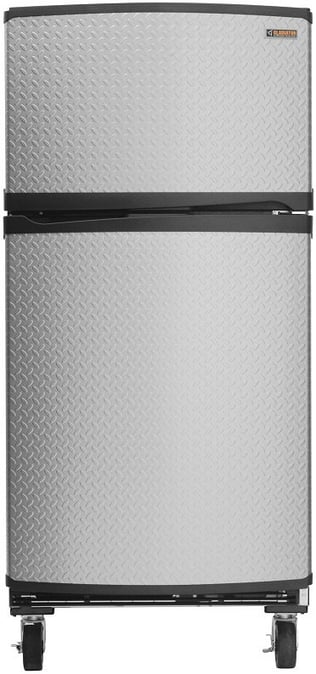Every year refrigeration capacities continue to climb. A standard sized 36-inch wide refrigerator used to fall in the 22-25 cu. ft. capacity range. Now the range is closer to 27-30+ cu ft.
One way that they have become larger is by having more efficient insulation that allows the walls to be thinner. The other way to get more capacity is becoming taller and deeper.
This can become problematic when you try to fit a bigger unit into an existing opening. The big consideration is the space required around the unit for proper ventilation of the compressor.
Built-in and integrated refrigeration have a dedicated open space with a grill built into the unit that allows for proper cooling of the compressor.
However, with standard and counter-depth units, you still need the compressors to breathe from the bottom of the refrigerator. If the refrigerator is too tight, the heat will seize the compressor.
With this in mind let's get into the actual specs and what can happen to your refrigerator if you don’t leave the proper space.
Looking for answers about Counter-Depth Refrigerators?
Short on time? Download our free Counter-Depth Refrigerator Buying Guide.
How Much Clearance Does a Refrigerator Need?

Samsung RF23J9011SR
Each refrigerator model will have different manufacturer specifications, but the dimensions below commonly fall within manufacturer recommendations. Make sure to check the specific manufacturer specifications for new refrigerator models you're considering.
Sides: You should leave between ½-inch to 1-inch of clearance between the walls and cabinetry.
Rear: You should leave a minimum of 1 inch, and preferably 2 inches of clearance. Typically, because of the electrical or water connection, this will help push the fridge out slightly away from the wall, but 1-2 inches is ideal.
Top: A minimum of ½-inch, and ideally 1 full inch of clearance above.
You should take all these dimensions and factors into consideration when measuring for your new refrigerator.
It is better to err on the smaller side and leave additional space for the unit to cool rather than trying to fit in the biggest unit for the space.
Now let us get into the WHY.
Looking for answers about Counter-Depth Refrigerators?
Short on time? Download our free Counter-Depth Refrigerator Buying Guide.
Why do I need proper space for my refrigerator?
In the past, refrigerator coils were usually on the rear of the units, which helped push it away from the wall and allowed the heat to dissipate properly.

Rear Refrigerator Coils
Now, the coils and components are located below the units. Ideally, if the fridge has proper spacing the grill below the unit will pull in cooler air as the coils and components heat up.
The warm air will travel behind the rear of the fridge and dissipate through the top channel. This keeps the coils and components cool, so they do not overheat.
Looking for answers about Counter-Depth Refrigerators?
Short on time? Download our free Counter-Depth Refrigerator Buying Guide.
A fridge without proper ventilation will show specific symptoms, some right away, and some over the course of a few years.
If the compressor runs at an above-average temperature for a prolonged period or is unable to properly cool down you may see the following issues:
- Poor cooling
- unusually loud compressor noise and vibrations
- an increase in electricity bills
- and compressor or condenser issues including component failure unusually early
Maintenance
You can prolong the life of your refrigerator.
Try to clean the front grill of your unit with a hose attachment once every few months, more often if you have hard surface floors and/or pets in the home. It's usually very simple to remove the toe kick at the bottom of the refrigerator.

Lower Toe Kick
Temperature and humidity can also play a factor in the performance of your machine.
An ideal temperature for a fridge to operate at its most efficient state is between 60-80 degrees.
Note that if you plan on putting a backup fridge in the garage, oftentimes the temperature swing is far outside of the maximum range of 50-100 degrees, especially in winter. You can buy special refrigerators for this application.

Gladiator Refrigerator
Ideal humidity in the home is somewhere in the 35-50% range. Low humidity typically would not be a cause for concern.
Humidity above 50% can cause condensation buildup, as well as increased electrical consumption. The condenser and compressor will have to work extra to cool the air down in the unit.
Lastly, if your fridge is ever in direct sunlight during the day, the compressor is working harder and using more electricity during this time due to sunlight.
This would be more pronounced without curtains or better sunlight-resistant windows. A surprising amount of heat will be transferred over to the doors of the unit.
What if I'm replacing a refrigerator in an older space?
Appliances follow cabinets. Typically, you will have a 30, 33, or 36-inch cabinet. Refrigerators are designed to fit within these cabinet widths.
However, most of the issues are height. Many of the newer refrigerators are taller than the older products of 10-15 years ago.
The other issue is the width of 15-year-old or older refrigerators.
When you purchase a new refrigerator, just measure the old refrigerator as well as the cabinet height.
With this information, you will be able to find the best refrigerator for space.
Additional Resources
Download the Yale Counter Depth Buying Guide with features, specs and inside tips to all the brands like Sub-Zero, Thermador, Jenn-Air, Viking, Gaggenau, Monogram and more. Well over 330,000 people have read a Yale Guide.
Related Articles:
Why Should You Trust Us?
It seems that every appliance review has nothing but glowing comments about almost every product, yet you read customer reviews and they are almost universally bad.
We are here to fill in the disconnect. We'll give you the best features, and the drawbacks as well, including reliability based on over 37,000 calls performed by our service team just last year. Our goal is to give you ALL the information so you know what's right for you.
Please consider subscribing or adding to the conversation in the comments below. We appreciate you stopping by.






